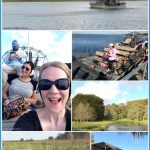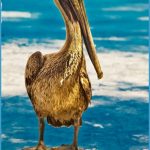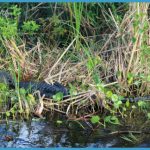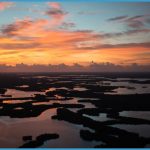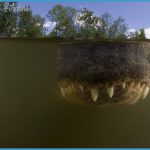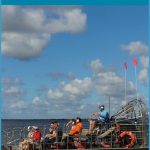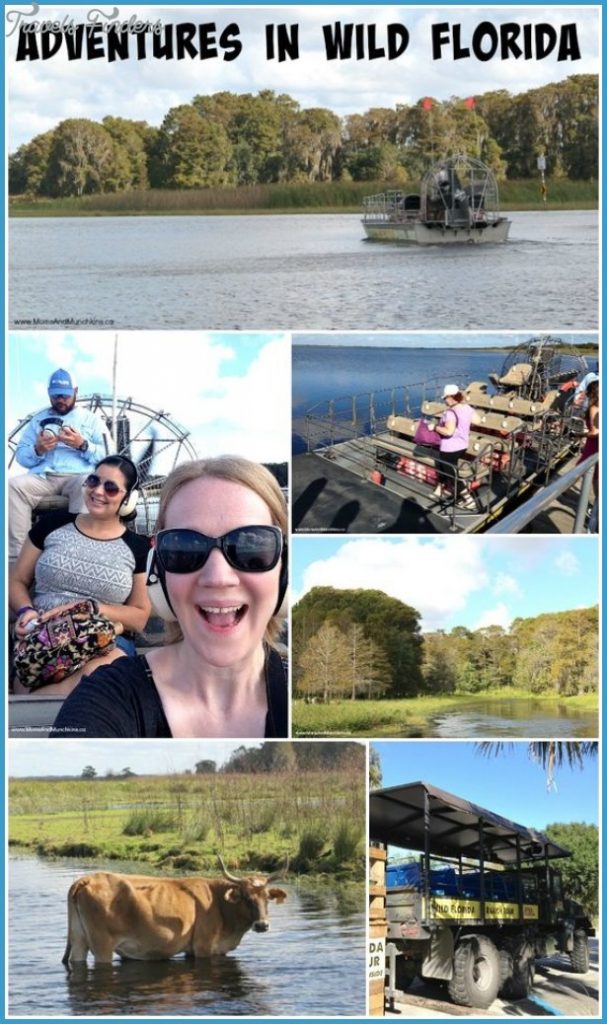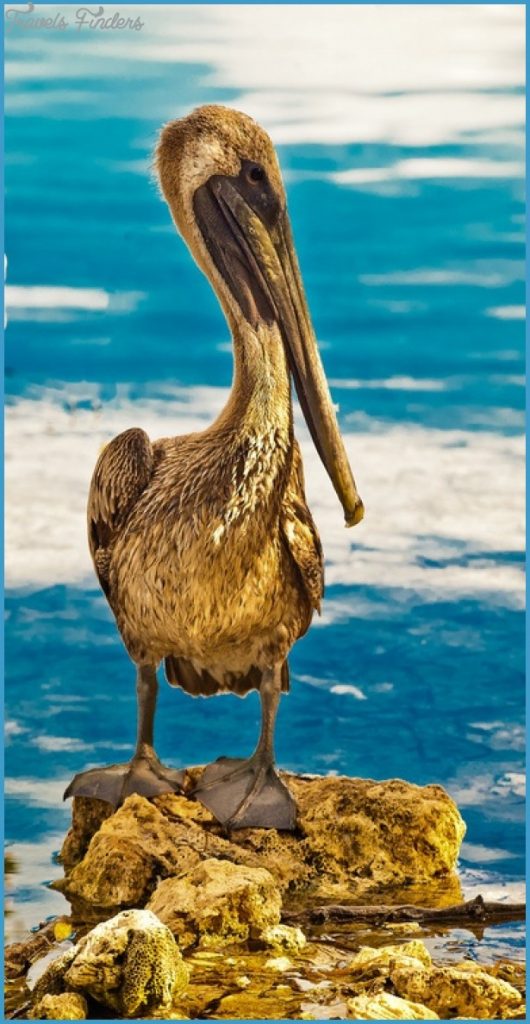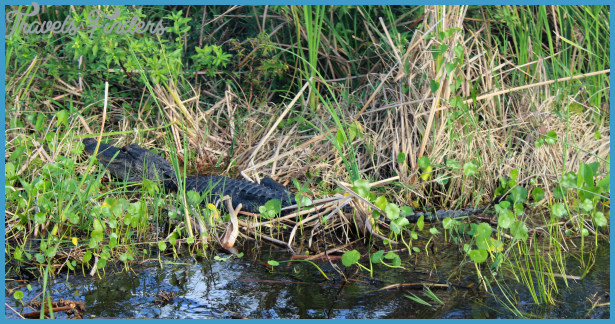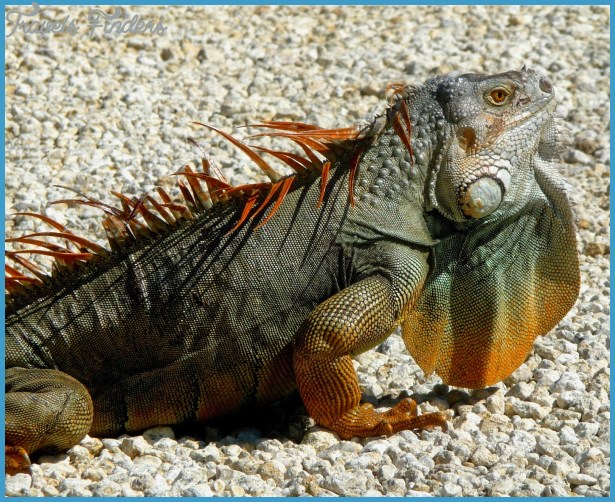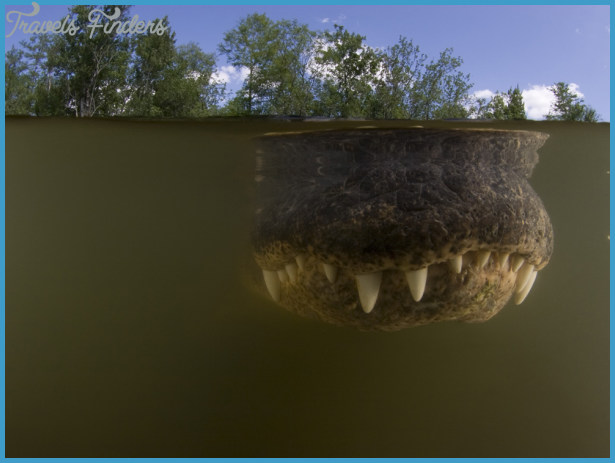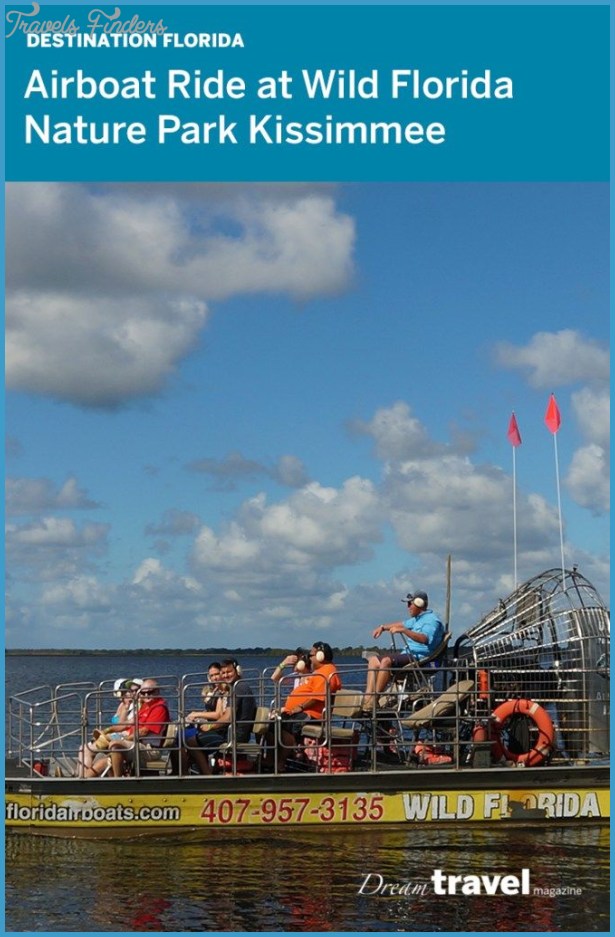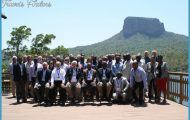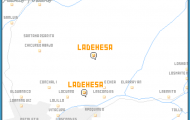On the dusty track of the Turner River Trail in Florida, the sauna-like, midsummer air is alive with the vibrant hum of squadrons of colourful dragonflies. Centuries-old Bald Cypress trees, their feet immersed in the turbid water, are draped with garlands of Spanish Moss. Flame-flowered bromeliads sprout from their damp, fissured bark. Star-shaped Swamp Lilies and a scatter of Cabbage Palms enliven brown expanses of tough sawgrass sedge. Butterflies the size of small birds do flypasts. In the plant-choked, water-filled shallows, huge, grey-as-slate, knobbly-skinned alligators rest uncannily motionless between Spatterdocks. Large turtles swim sluggishly or sun themselves on a protruding branch while tree frogs emit loud grunts. White-tailed Deer are common, even a few Black Bears and Florida Panthers still hunt in these marshes but are rarely seen amid the rampant vegetation. A Green-backed Heron, a miniature hunter, clings waxwork-still on the twisted shoots of a red-barked Gumbo Limbo tree while Turkey Vultures float languidly above. The day sky above the Florida Everglades no longer turns dark with birds as the American artist, John James Audubon, described in his visit here in 1832. But the wildlife in the primeval swamps of the Big Cypress National Preserve, part of the northern Everglades, is guaranteed to astound you still.
This huge, subtropical wetland is a wildlife paradise. Its sawgrass marshes; swampy forests; mangrove islands; shallow, coastal waters and sea-edge coral reefs support over 11,000 different seed-bearing plants as diverse as tree-hugging Strangler Figs and the blue spikes of Pickerelweed. It is hearth and home to over 300 bird species, from black and scarlet Pileated Woodpeckers to the peculiar Snakebird, so named because it swims underwater with only its reptile-like neck visible. The key to this vast animal richness is less obvious. The heavy rains of summer, combined with the shimmering heat of the Florida sun, send microscopic water-living plants and animals into a reproductive frenzy. Called periphyton, yellow-green mats of this mix float on the water. It feeds an array of insects – including the larvae of the Everglades’
prolific mosquitoes – tadpoles of frogs and other amphibians, plus a myriad of tiny fish. In their turn, they fall prey to larger fish, birds and reptiles a rung further up the fast-food ladder.
In Florida Bay – into which Everglades water eventually seeps – the shallow, brackish waters are home to Red Mangroves that rise tiptoe on claw-like prop roots to form hundreds of tiny islands. Each is an impenetrable tangle of roots and shoots that shelter a wealth of creatures and protects the coast when storms hit. Fish-eating birds of prey such as Ospreys and a cornucopia of egrets and herons nest in the mangrove tops. Sea turtles; Spiny Lobsters; fish with peculiar names like Drum, Porgie and Sailfin Molly; and endangered species like the American Crocodile and the lumbering Florida Manatee swim in their shadows.
In 2001, I went to the Everglades because of a plan signed into law in the last days of the Clinton Presidency. This vast wetland occupying much of the bottom half of Florida State had been badly damaged and modified for over a century but, at last, there was hope that it was going to be restored to something approaching its former glory. Drainage, diversion of its lifeblood – water – building development and intensive sugarcane growing had all had an enormous impact. And Saga Magazine had commissioned me to write a feature about what the future might hold.
This story is not so much about the experiences that I can recall from a fortnight’s visit to the south of the USA’s Sunshine State’. There were experiences of course; memorable helicopter rides to get a bird’s-eye view of the huge shallow wetlands constructed from sugarcane fields to provide pollution soak-ups; my first glorious views of a family of River Otters making their way casually along a waterside track; of hopelessly flamboyant Roseate Spoonbills feeding in watery shallows; and much more beside. I’ve included the story because it was the most complex issue I have ever had to grapple with in order to produce a well-rounded feature for a readership I had to assume would know little if anything of the wildlife impact of water pollution and the perils of too much water abstraction. And why should they. OK, I had 3,000 words in which to explain what had happened to severely damage one of the world’s great wetlands, why that mattered and how the damage might be put right. And 3,000 words is a long feature. But it was probably the hardest writing job I have ever done. It was not made any easier when, as often happens, I discovered a far more complex set of issues – and less conformity on how to deal with them – than I imagined when I first suggested the idea to Saga Magazine!
You might recall the time that Clinton put his signature on the relevant piece of paper to start the long process of recovering the Everglades. Though, if you do, it will be for a very different reason. In December 2000, US media outlets were replete with seemingly arcane discussions about some other, very much smaller bits of paper. The implications of hanging, dimpled, and pregnant chads on Florida State’s punch-card voting slips used in the Presidential Election race between Al Gore and George W Bush were getting more public attention than whoever invented the voting system could possibly have imagined. Re-counts to determine which way Florida had voted were relying on an interpretation of punch holes which had, or hadn’t, been perfectly formed. With legal challenges growing by the hour and Florida’s Supreme Court and the US Supreme Court jolted into action, Florida’s critically close count determined who would enter the White House and succeed Clinton. After days of wrangling, Bush was declared the winner (though Gore had won the total count US-wide) and the rest, as they say, is history. Upon some chads was the West’s future involvement in Iraq and much subsequent Middle East turmoil, death and suffering determined.
In the middle of all this debacle, it isn’t surprising that virtually no one noticed that President Clinton, carrying on business much as normal in the White House, signed up to the costliest public works project in US history, almost certainly the costliest the world has ever seen. It was all about water in the Everglades. It was to replumb Southern Florida, an area at least half that of Scotland. And it was to cost more than £9,000 million over the next 30 years.
First, I had to get some basic background. Until American soldiers pursued Seminole Indians through this lush, subtropical wilderness in the mid-1800s, no Westerners’ had set foot in it. For thousands of years, its waters flowed on a 500 km journey south through vast Lake Okeechobee to the crystal-clear mangrove shallows of Florida Bay.
Seldom more than two feet deep, this river of grass’ – as Marjory Stoneman Douglas, the US writer and environmentalist, dubbed it – was nearly 100 km wide. Devoid of any currents or rapids, it mooched south across a virtually flat landscape. Its waters took years to reach the sea. Not surprisingly, its vast sawgrass marshes and wet Cypress woods churned with life.
One of the first people I interviewed was Johnny Jones, the ex-Executive Director (and the first) of the Florida Wildlife Federation (FWF), a powerful environmental campaign organisation in the state. Jones had been a plumber and was in love with the Everglades from his early years. He recalled being out in the swamps as a young man: I’d hacked my way through half a mile of tall sawgrass to reach some open space,’ he recalled. Just before I broke out I heard a loud noise like a shot from a cannon. It was the wings of ducks. It seemed like millions of ducks, Mallard and Pintail, herons and egrets. They took off like a cyclone, only bigger. They blocked out the sky.’ It was the early 1950s. Jones led the FWF from 1971 to 1986, campaigning for much of the legislation in place today protecting large parts of this vast wetland. He died in 2010.
But when Jones saw – and heard – his cyclone of ducks, the Everglades was already changing fast. Wetlands were thought of as pestilential wastes. Selling land cheaply, the developing Florida State had long been encouraging settlers to build canals and drain the land, creating an agricultural Eden on fertile, peaty soils. Sugarcane has long since grown where a young Johnny Jones saw a sky-full of birds. When seasonal floods and hurricanes killed thousands of people in the 1920s, the state funded yet more canals and protective banks or levees. By the 1970s, the US Army Corps of Engineers had completed one of the most ambitious engineering projects ever. They had surrounded Lake Okeechobee at the northern end of the Everglades with a massive embankment that plugged the natural, sheet-like flow of water south across the marshes and down to Florida Bay. Meanwhile, well over 2000 km of levees and canals, and umpteen pumping stations, diverted water out of the marshes and into the sea. Three Water Conservation Areas covering nearly half a million hectares were created out of the northern Everglades swamps; these were flooded year-round as shallow, water supply reservoirs for the burgeoning urban population. No longer did their water levels alter with the seasons as they had for millennia; now their levels were determined by water use in the growing centres of Miami, Palm Beach, Fort Lauderdale and elsewhere. They remain rich habitats but much of their typical wildlife has long gone.
All this re-plumbing cost the Everglades dear; ever since, what was left of the once vast marshes has been on life support. Its original 4 million ha, an area twice the size of Wales, had shrunk by half, converted to urban high-rise, farm crops or water storage. Over 60 of its plant and animal species are endangered, including the Wood Stork, down from around 20,000 pairs in the 1930s to a few thousand when I was there, and the enigmatic Florida Panther, perhaps 70 of which remained then. Egrets and herons have plummeted by 90% since the 1960s.
The area has a plethora of wildlife tourism businesses, both near the Everglades and around Florida Bay at its southern end. I talked to one: Capt. Sterling’s Everglades Tours operating out of Key Largo (‘where reality ends and tranquillity begins’) near the mainland end of that attractive chain of islands – the Florida Keys – that arc their way out into Florida Bay. I started here 20 years ago’ says Sterling Kennedy who runs the business. I used to take people in an evening to watch thousands of storks, herons, egrets and Roseate Spoonbills roosting on one particular mangrove island in Florida Bay. Now I don’t bother. There’s few birds there any longer.’ Most other tourism operators told me the same; few places that are accessible in and around the Everglades are as rich in wildlife as they used to be. Most are a pale reflection of what was once here. I was finding it all pretty depressing.
The plan that Clinton signed off in December 2000 in order to deliver Federal US funding (in addition to Florida State funding) is the Comprehensive Everglades Restoration Plan, known as CERP. It had been hammered out over years by an unlikely alliance of Federal and Florida State engineering, water supply and conservation Agencies, native Indian Tribes who still have reservations’ in the area and farming interests. It also had considerable political support from the then State Governor Jeb
Bush, George B’s brother and now a contender for the Republican nomination to run for President in November 2016.
To get everyone on side, though, it had to guarantee water for a 250,000 ha of some of the most productive farmland in the world and supply drinking water to the 6 million people who live year-round in Southern Florida (the population of Greater London) and another 12 million that join them in winter, mostly other Americans getting away from the ferocious northern winter. The cash, half from Federal coffers and half from the state, is intended to build over 300 deep underground water storage wells, each costing up to £1 million, and a series of reservoirs.
From all this you might think that Florida is short of water. It isn’t. What it’s short of is the means and the determination to hold and manage what they do get so that the environment doesn’t suffer. Florida receives 150 cm of rain a year, over twice that of southern England where the largest sector of Britain’s population resides. But the Sunshine State wastes much of it, using drinking water to irrigate golf courses and gardens. Wastewater recycling plants are scheduled to help put that right as part of the plan to manage this precious resource more carefully.
I interviewed David Struhs, appointed in 1999 by the Governor as Secretary of Environmental Protection in Florida, and a Bush family friend. At the time, he was responsible for the state’s implementation of CERP. This plan is our single highest environmental priority here in Florida. It makes good sense; it’s not just nice to do, it’s fundamental,’ he told me. We must protect the Everglades and plan for the predicted doubling in our population over the next 50 years. I can’t see any sensible alternatives. It could prove to be one of the largest examples of sustainable development anywhere,’ he adds.
But others were critical. Shannon Estenoz was then the Everglades Programme Director for the Worldwide Fund for Nature (WWF) and I met her to get her views.
‘With other campaigning groups we intend keeping up the political pressure to ensure that the urban lobby doesn’t hijack the CERP. If Secretary Struhs believes that the urban population can grow for another 50 years because they can get enough water – and_we can restore the Everglades at the same time – he’s being unrealistic,’ she adds. In 2014, US Secretary of the Interior in the Obama administration, Ken Salazar, announced the appointment of Estenoz as Director of Everglades Restoration Initiatives, his senior representative in South Florida for Everglades restoration.
According to the South Florida Water Management District, who are in the forefront of getting the work done, CERP will return most of the pre-drainage flows to the Everglades, mimicking the age-old pattern of summer wet seasons and drier winters. But water quality is as important as water quantity. Six wetlands (called Stormwater Treatment Areas, STAs) – over 20,000 ha dense with bulrush and willow or awash with floating plants like water lilies – are being built between the intensive sugarcane-growing farmland and the Everglades to absorb polluting phosphate from fertilisers before the water flows into the swamps.
Because all of this land is pancake flat, it’s impossible to visualise these STAs by standing on a small embankment at their edge. So the Water Management District offered to fly me over some of them so that I could see them properly. It wasn’t an offer I was going to refuse. Hovering just a couple of hundred metres above them, the waters were green with algae; stands of bulrush and willow grew at the edges and these vast shallows, sometimes covered in water lilies, seemed to stretch almost as far as we could see from the helicopter seats. The largest – at 6,500 ha, a huge wetland by UK standards – was costing £67 million to create, most of it spent on embankment building, levelling the land, building pumping stations and redirecting canals. A few years ago this had been wall-to-wall sugarcane. Laced copiously with fertiliser every year, much of the phosphate in the fertiliser would run off into the general southerly flow of water into the Everglades marshes, changing the composition of its natural vegetation and stimulating the growth of plants not naturally common here. Now the lush plant growth in the STAs would use up all the phosphate instead.
There were few birds visible in the STAs from up here and our pilot was more concerned about large birds in the sky around us. We had flown past a couple of Turkey Vultures earlier and he gave them a wide berth. They’re our main hazard out here’ he said. We are often flying at a height where they soar and you don’t want to hit one of them. A colleague of mine had one crash through the cockpit glass one day; he was injured but he managed to keep control and land the copter safely. He was very lucky.’
Because of phosphate getting in from the sugarcane crops in the past, 25,000 ha of sawgrass – the dominant, natural plant cover over much of the Everglades -has been ousted by cattail (bulrush), a toughie that does well where fertilisers pollute water. It grows so densely that any open water amongst the sawgrass, where most of the diversity of plants and fish exists, gets covered by it. Water Management District experts told me that it will take many decades for the sawgrass to return once phosphate is eliminated. So far, phosphate levels in the water entering the Everglades after travelling slowly through the STA wetlands have been reduced tenfold but the intention is to get it lower still.
For another angle on the same issue – a fundamental tenet of (hopefully) good journalism – I arranged to meet Rick Roth, the owner of Roth Farms and at that time Vice President of the Florida Farm Bureau. We walked over some of his vast sugarcane, vegetable and rice fields’, part of his 2,000 ha estate near West Palm Beach. He argued that farmers have been using improved farm practices to reduce fertiliser runoff for years. Surprisingly, though, he was not set against the state buying up some farmland to flood the STAs. Phosphates aren’t the problem they used to be,’ he says. Our taxes go up if we don’t keep phosphate levels down so it’s in our interest to do so. But the STAs will bring it down more. The Plan is a good compromise because it lets us continue farming, restores the Everglades and improves water supply. Everyone wins,’ he adds.
To help achieve more natural water flows through these vast marshes, 400 km of drainage canals are scheduled for infilling as part of CERP. Like many fishermen, Aaron Spicer isn’t too happy about this; I had a chat with him as he fished from the grassy bank of a canal near Homestead in the very south of Florida. I come out here most weekends from Miami with my family. We fish these canals. They’re good for Black Crappie and bass. We don’t want them filled in,’ he argues passionately as several other fishermen look on.
But fisheries experts point out that the loss of some canals will be nothing compared with the potentially huge gains in fish populations as a result of the changes to be made. In the Everglades, where inches are everything, areas of slightly deeper water will dry out much less frequently, boosting depleted populations of insects, amphibians and birds too. Reinstating natural water flows doesn’t come cheap. Both Interstate 75 (known here as Alligator Alley) and US 41 (the Tamiami Trail), the two major roads cutting west/east across the Everglade swamps, will have culverts installed or embanked sections replaced by low bridges to allow natural north/south water flows once again.
The results of all this restoration won’t be felt quickly. Typical was the reaction of Dr Bob Johnson, Director of the South Florida Natural Resources Centre at the Everglades National Park and a renowned Everglades expert. We’ll have to wait and see how things recover. The Plan will supply about three quarters of the water we calculate we need but more could be necessary,’ he told me. Nevertheless, Johnson was optimistic that improvements would occur.
The Seminoles, the largest Native American tribe in Florida with 2,800 members, are sharing the cost of a £33 million restoration of their huge reservation north of Big Cypress. They’re optimistic too. We want to see the Everglades restored’ Jim Shore, General Counsel to the Tribe told me. Too much has been destroyed. The money will restore nearly 6,000 ha of swamp and forest but we will also be building some water storage areas to improve our citrus crops and cattle ranching.’
It didn’t take long for me to realise that Everglades restoration was not all about water, even though it’s easy to get that impression. There are huge problems with introduced plants that have literally gone wild, frequently at the expense of the locally native species. I arranged to meet Dr Mike Norland at the Everglades National Park’s HQ; he’s an expert on them. He told me that three quarters of a million hectares of the marshes are overrun with introduced plants like Brazilian Pepper (a South American evergreen tree reaching 10 m in height that thrives in swamps) and Paperbark trees (an Australian import that takes over from native sawgrass), ousting a host of native swamp species. CERP aims to speed up their removal but it’s a costly and difficult business. When I was there in 2001, contractors were in the midst of clearing a dense, 2,000 ha forest of Brazilian Pepper within the national park; the land was being returned to wetland a bit at a time. We cut it with heavy machinery, chip it, and then scrape off the soil so it can’t seed into it. All the typical wetland plants and animals are coming back slowly’ Mike told me as we looked out on yet another dense growth of the dreaded tree, a clump so dense that there seemed next to nothing growing amongst it.
As if the marshes here didn’t have enough issues for me to try and write about,
I soon found out that the end-point for all this water – Florida Bay at the southern tip of the state – had problems too. I hadn’t bargained on that! Looking across the aquamarine glare of these subtropical waters from Key Largo towards Florida’s southern tip, shallow discs of mangrove islets pepper the scene, some tiny, others much larger. Around them cumbersome Brown Pelicans lunge into the waters, piratical, red-throated Magnificent Frigatebirds duck and dive to harass other birds for a free feed and cormorants dive for fish. Idyllic is a description that comes readily to mind.
Wildlife Travel To Florida Photo Gallery
But I was learning fast that superficial impressions can easily deceive; idyllic this place seemingly isn’t. Pouring more water into the sea sounds harmless enough. But in Florida Bay, the Everglades CERP doing just that is proving highly controversial. Florida Bay has been much altered by the water that flows into it, the water that filters its way through the great Everglades marshes. The Bay’s once crystal clear waters now often resemble a pea soup, brimming with abnormal loads of mud and plankton, tiny plants and animals that have proliferated. Seagrasses that used to grow rampant and anchor its muddy sea bed – vital nurseries for invertebrates, young fish and shellfish – have died off, causing declines in Pink Shrimp, Spiny Lobsters and fish like Red Drum. Numbers of mangrove-breeding Wood Storks, scarlet-beaked White Ibis and gorgeous pink and carmine Roseate Spoonbills plummeted from around 300,000 in the 1930s to less than 30,000 in the 1990s. Ospreys, lumbering Florida Manatees and American Crocodiles have all declined; and the £39 million Pink Shrimp and £15 million Stone Crab fisheries have taken big knocks here too. Tourist brochures, of course, remain replete with dazzling pictures of birds, alligators and manatees. We see a lot of local publications with pretty pictures of spoonbills’ comments Dr Jerry Lorenz, a biologist with the National Audubon Society who has been studying these birds since 1989. But I’m down here watching the birds go all to hell,’ he says ruefully.
Parts of the impressive coral reefs that stretch the length of the Florida Keys are dying off. In places up to 80% of the massive, branching Elkhorn and Staghorn Corals, and lattice-work Sea Fan corals that waft gently in the warm water, have been killed or are badly diseased. Nearly 600 species of fish depend on these corals; flamboyantly coloured species like the Rock Beauty, blue and yellow striped Grunts, and the aptly named Parrotfish live here alongside an array of sponges, shrimps, crabs and turtles. But expert opinion differs on the causes of these die-offs. Some put the seagrass kills down to the Bay’s water becoming more salty because not enough freshwater has been getting into it from the Everglades for decades. Others, like Dr Brian Lapointe of the Harbor Branch Oceanographic Institution, pin the blame on nitrogen in fertilisers washing through the Everglades from farmland way to the north. He believes that restoring freshwater flows through the Everglades will kill more coral and seagrass, not less, because the STAs, while they reduce phosphates considerably, only cut fertiliser nitrogen by half.
The Environmental Protection Agency’s Dr Bill Kruczynski is convinced it isn’t that simple. I’d like to have an easy answer,’ he says, But the data just doesn’t support it. Some coral reefs well away from any pollution are dying too. There are other factors like fishing, climate warming and sewage discharges from thousands of cesspits and septic tanks in the Keys. It will cost £430 million for a proper sewage system here, money that’s not in the CERP,’ he says. Nevertheless, building permits are now harder to get on the Keys and there are proposals to modernise its sewage treatment.
The problems I heard about in Florida Bay are not just an ecological disaster; they’re a potential economic disaster too. A multi-billion dollar tourist, fishing, diving and snorkelling industry depends on its good health. And, as you might expect, tourism operators have their own take on what’s behind all the ecological change that threatens their livelihoods. Rarely has so much depended upon pouring some water into the sea. I’ve been diving these reefs for 35 years,’ John Bell at Sharky’s Reef Tours told me, one of many such businesses in Key Largo, and I’ve seen a huge die-off of corals. It’s depressing. If the corals die, guess who dies off next!’ Captain Dave Lee, who has been leading backcountry fishing trips in the Bay for nearly three decades, thinks some of these changes are natural. If they can mimic the old flow conditions down through the marshes, that’ll boost fish numbers. It’s either too salty or too fresh now; the flows are on and off. But I’m not sure they can achieve it,’ he adds.
Thirty years is a long time to see this massive project through. It has the necessary legal backing but it relies on continuing state and federal political commitment to keep the cash flowing. There is a much bigger factor too. Any amount of cash and replumbing is impotent if climate warming produces the predicted sea level rise of up to 5 cm a decade. With the highest ground just 6 m above current sea levels, within a century the sea could inundate much of the southern Everglades.
The late Marjory Stoneman Douglas, who remains an inspiration for those who seek to protect the Everglades, had a simple answer: The Everglades is a test,’ she once wrote. If we pass it, we get to keep the planet.’
Postscript:
When I wrote the feature for Saga Magazine I posed the obvious questions: Will it work? Will it run out of political steam, unfinished as government cash gets diverted to more pressing and immediate priorities such as terrorism? Or will it turn into a water supply project for farmers and city dwellers, as some critics warn, relegating the desperate need to resuscitate the Everglades to a nice to do’ extra that never quite gets done? Maybe you are wondering about the answers. So am I, but I don’t intend spending weeks trying to evaluate what has – and what has not – been achieved so far, analysing the maelstrom of disparate information that’s available in various reports. It is early days in the 30-year CERP plan which is trying to put right some of the damage caused by over half a century or more of land mismanagement.
What is clear is that, with George Bush as President from 2001 to 2009, the federal commitments promised by Clinton withered, and withered very substantially, as priorities switched to countering terrorism at home and to foreign invasions. Bush tried to cancel all federal investment against the wishes of Florida’s Republicans and his brother, Florida Governor Jeb Bush, but he was overruled by Congress. What a contrast there would have been, it is safe to assume, had Al Gore – a fervent environmentalist – become the 43rd US President.
The State of Florida reports that it has spent more than £1,300 million on the various projects since CERP was signed. More than 15,000 ha of STAs have been built to filter phosphorus from Everglades waters. Fifty-five percent of the farmland necessary for restoration – 85,000 ha – has been purchased by the state, and environmental groups are pressing for more purchases. Some water storage reservoirs for urban supply have been built but environment groups claim that more effort and cash is going into securing water for the growing urban areas than into Everglades restoration. There are claims, too, that the whole plan is lost in a maze of bureaucracy, a victim of analysis paralysis’ partly caused by the big sugar producers slowing down the process by influencing politicians. What a surprise.

